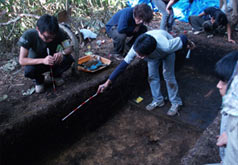Our department is very active in archaeological fieldwork and excavations. The following are some recent examples.
Zozan (Tsukuriyama) tumulus
Zozan tumulus in Okayama prefecture is the fourth largest keyhole-shaped burial mound in the Japanese Archipelago constructed in the former half of the fifth century. We conducted a digital survey in 2007 and started an excavation project from 2008 which is currently ongoing.

Igozori site
Igozori site in Tottori prefecture is a Jomon settlement site. The site was repeatedly used throughout the Initial, Early to Middle, Late and Final Jomon periods. We excavated the site in 2007 and 2009 and obtained important pollen and phytolith data in order to reconstruct climate changes of the area from the Jomon period to the present.

Desaki Funakoshi-minami site
This site is situated on a small peninsula in the south of Okayama prefecture. We excavated a peat deposit belonging to the Early Jomon period and obtained important data in order to understand the changes in climate and landscape.

Shobuzako tumulus
Shobuzako tumulus in Okayama prefecture was excavated by our Department from 2001 to 2008. The tumulus turned out to be a 42m long scallop-shaped burial mound which contained an undisturbed burial chamber with rich burial goods and skeletal remains.

Nima Otsuka tumulus
The tumulus in Okayama prefecture is a 38m long keyhole-shaped burial mound constructed in the middle sixth century. Our excavation from 2001 to 2004 revealed that the corridor style burial chamber is one of the earliest in the Kibi area. Very rich burial goods including sue-ware, iron implements, a bronze mirror, horse bells and more than 700 beads were found from the chamber.


